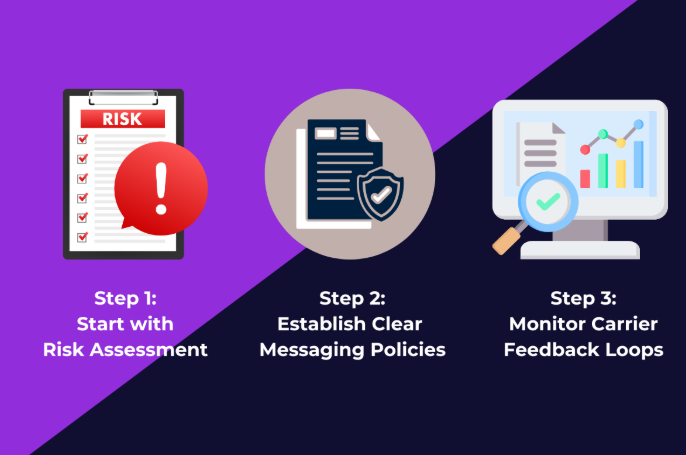October 8, 2025
4 minutes read
Messaging Compliance Solutions: How to Stay Safe and Avoid Penalties

Business messaging has become one of the most powerful channels for customer engagement, but it’s also one of the most heavily regulated.
From data privacy laws to carrier rules, companies that send SMS or text messages must take compliance seriously.
Failing to follow established standards can lead to costly penalties, reputation damage, and even blocked campaigns.
This guide explains how to navigate messaging compliance solutions effectively, helping organizations maintain trust and avoid unnecessary risk.
Why Compliance Matters
Regulators worldwide are tightening standards on digital communications.
In the United States, the Telephone Consumer Protection Act (TCPA) and CAN-SPAM Act set strict boundaries for promotional messages.
In Europe, the General Data Protection Regulation (GDPR) enforces consent and data protection

Mobile carriers add their own compliance rules for messaging, which businesses must respect to keep their traffic flowing.
Ignoring these standards isn’t an option. Fines can reach thousands of dollars per infraction, and carriers may block non-compliant senders outright.
Common Compliance Categories
Compliance refers to multiple types of approaches, so here are all the categories that fall under the various compliance rules and guidelines:
- Consent & Opt-In – Users must clearly agree to receive texts.
- Opt-Out Mechanisms – Every message should make it easy to stop future contact.
- Content Standards – Prohibited topics (like illegal goods) or deceptive language are off-limits.
- Data Privacy – Storing and processing phone numbers must align with privacy laws.
These requirements are the foundation of SMS message compliance, as well as text messaging compliance in general, throughout every major market.
Building a Strong Compliance Strategy in 3 Steps
Even though it’s a completely serious issue, that really doesn’t mean that compliance equals complexity. We broke down the whole process into 3 steps, so let’s take a look.

Step 1: Start with a Risk Assessment
Audit current practices: Where are opt-ins stored? Are unsubscribe requests honored in real time? Reviewing policies will help you identify gaps before they attract fines.
Step 2: Establish Clear Messaging Policies
Write straightforward internal guidelines covering:
- Consent management
- Message frequency limits
- Required disclosures in promotional texts
- Secure handling of customer data
Make sure to document these steps on your way to achieving full compliance for text messages.
Step 3: Monitor Carrier Feedback Loops
Carriers track spam complaints and delivery rates. Set up alerts for spikes in complaints (or sudden drops in deliverability), as these can provide an early warning that a campaign may violate text message compliance requirements.
Experienced teams all over the world use these strategies to adjust outreach before issues escalate.
Technology That Supports Compliance
Manual oversight only goes so far. Modern messaging compliance solutions automate much of the heavy lifting:
- Consent tracking tools that log opt-ins and opt-outs
- Automated scrubbing of Do-Not-Contact lists
- Templates that enforce required language or disclosures
- Delivery reports to validate message routing and content
When choosing technology, look for systems that combine automation with visibility. A unified messaging inbox can consolidate SMS, email, and chat threads, making it easier for teams to spot and resolve compliance issues quickly.
A reliable messaging API is equally important because it allows businesses to integrate compliance checks directly into workflows rather than relying on manual review.
Additional Tips for Text Messaging Compliance
Beyond the basics, there are additional strategies every business should follow to maintain text messaging compliance and protect its reputation. Let’s analyze them below:

Write Messages with Care
Avoid misleading phrasing and always identify the sender. Include opt-out language such as “Reply STOP to unsubscribe” in every promotional text.
Respect Timing and Frequency
Many regions limit sending during certain hours. Keep outreach reasonable, because one thing is certain - over-messaging invites complaints and scrutiny.
Keep Records
Store evidence of consent, message content, and delivery confirmations. Should a dispute arise, proper records demonstrate adherence to mobile messaging compliance standards.
Example of a Compliance-Friendly Text
A proper compliance message example could be:
“Thanks for joining [Brand]! Get 10% off your next order. Reply STOP to opt out.”
This way, you keep marketing intent transparent while giving customers immediate control.
Why Compliance and Marketing Go Hand in Hand
Some people say that good compliance limits marketing, but in reality, it actually strengthens it. Respecting customer preferences increases engagement and reduces opt-outs.
For example, when launching SMS marketing campaigns, segment audiences and send relevant offers only to those who requested them.
Simply put, a thoughtful marketing campaign builds loyalty without crossing regulatory lines.
Solutions to Simplify Oversight
Partnering with specialized platforms can reduce the burden of ongoing monitoring. The advanced systems that these platforms have can evaluate messages against global rules before delivery, helping businesses stay within safe boundaries.
If you are considering scaling your outreach, providers like TopMessage offer end-to-end tools for business messaging with compliance, including delivery optimization and built-in safeguards for promotional flows.
Taking the Next Step
Following proper compliance practices in business messaging goes beyond avoiding fines because it gives you the opportunity to build trust and strengthen customer connections.
Clear policies, automated safeguards, and careful monitoring of delivery and complaints help companies communicate confidently.
And, if you’re thinking of asking for help outside your organization, solutions like TopMessage are surely worth considering. With platforms like this, you can add another layer of security, making it easier to send messages that meet regulations while keeping engagement high.
FAQs
What happens if a business violates text messaging laws?
Penalties vary by jurisdiction but often include fines, legal fees, and carrier blocks. Repeat violations can lead to permanent suspension of sending rights.
Is text message compliance only for marketing texts?
No. Any transactional or service message must respect privacy, security, and timing standards.
Do small businesses need to worry about regulations?
Yes. Laws apply to businesses of every size. Even a single promotional text sent without consent can result in fines.
How often should compliance processes be reviewed?
At least annually or even sooner if launching new channels, updating software, or entering new regions.
Can automation fully replace human oversight?
Automation is valuable, but human judgment remains essential for context, creative review, and adapting to evolving laws.